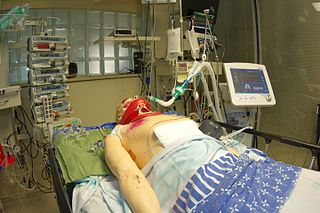
A simulation is an imitative representation of a process or system that could exist in the real world. In this broad sense, simulation can often be used interchangeably with model. Sometimes a clear distinction between the two terms is made, in which simulations require the use of models; the model represents the key characteristics or behaviors of the selected system or process, whereas the simulation represents the evolution of the model over time. Another way to distinguish between the terms is to define simulation as experimentation with the help of a model. This definition includes time-independent simulations. Often, computers are used to execute the simulation.

Mixed reality (MR) is a term used to describe the merging of a real-world environment and a computer-generated one. Physical and virtual objects may co-exist in mixed reality environments and interact in real time.

Medical education is education related to the practice of being a medical practitioner, including the initial training to become a physician and additional training thereafter.
Roleplay simulation is an experiential learning method in which either amateur or professional roleplayers improvise with learners as part of a simulated scenario. Roleplay is designed primarily to build first-person experience in a safe and supportive environment. Roleplay is widely acknowledged as a powerful technique across multiple avenues of training and education.
An objective structured clinical examination (OSCE) is an approach to the assessment of clinical competence in which the components are assessed in a planned or structured way with attention being paid to the objectivity of the examination which is basically an organization framework consisting of multiple stations around which students rotate and at which students perform and are assessed on specific tasks. OSCE is a modern type of examination often used for assessment in health care disciplines.
In health care, a simulated patient (SP), also known as a standardized patient, sample patient, or patient instructor, is an individual trained to act as a real patient in order to simulate a set of symptoms or problems. Simulated patients have been successfully utilized for education, evaluation of health care professionals, as well as basic, applied, and translational medical research.
Hertfordshire Intensive Care & Emergency Simulation Centre (HICESC) is an advanced teaching facility based at the University of Hertfordshire. At its creation in 1998, it was an inter-Faculty practical laboratory hosted by the Department of Electronic, Communication and Electrical Engineering (ECEE) for access by medical engineering students and jointly established by the Department of Nursing and Paramedic Sciences, Faculty of Health and Human Sciences for use by their students.
A serious game or applied game is a game designed for a primary purpose other than pure entertainment. The "serious" adjective is generally prepended to refer to video games used by industries like defense, education, scientific exploration, health care, emergency management, city planning, engineering, politics and art. Serious games are a subgenre of serious storytelling, where storytelling is applied "outside the context of entertainment, where the narration progresses as a sequence of patterns impressive in quality ... and is part of a thoughtful progress". The idea shares aspects with simulation generally, including flight simulation and medical simulation, but explicitly emphasizes the added pedagogical value of fun and competition.

Medical simulation, or more broadly, healthcare simulation, is a branch of simulation related to education and training in medical fields of various industries. Simulations can be held in the classroom, in situational environments, or in spaces built specifically for simulation practice. It can involve simulated human patients, educational documents with detailed simulated animations, casualty assessment in homeland security and military situations, emergency response, and support for virtual health functions with holographic simulation. In the past, its main purpose was to train medical professionals to reduce errors during surgery, prescription, crisis interventions, and general practice. Combined with methods in debriefing, it is now also used to train students in anatomy, physiology, and communication during their schooling.
An instructional simulation, also called an educational simulation, is a simulation of some type of reality but which also includes instructional elements that help a learner explore, navigate or obtain more information about that system or environment that cannot generally be acquired from mere experimentation. Instructional simulations are typically goal oriented and focus learners on specific facts, concepts, or applications of the system or environment. Today, most universities make lifelong learning possible by offering a virtual learning environment (VLE). Not only can users access learning at different times in their lives, but they can also immerse themselves in learning without physically moving to a learning facility, or interact face to face with an instructor in real time. Such VLEs vary widely in interactivity and scope. For example, there are virtual classes, virtual labs, virtual programs, virtual library, virtual training, etc. Researchers have classified VLE in 4 types:

Harvey was one of the earliest medical simulators available for training of health care professionals. Harvey was created in 1968 by Dr. Michael S. Gordon at the University of Miami. Harvey is currently sold by the Laerdal Corporation.

Eugene Weston Hobbs II, known as Gene Hobbs is an American technical diver and founding board member of the non-profit Rubicon Foundation. Hobbs has served as medical officer for the Woodville Karst Plain Project since 2004 and was named the 2010 Divers Alert Network/ Rolex Diver of the year. Hobbs was a hyperbaric technologist and simulation coordinator at Duke Medical Center before taking a position as the Director of Simulation for the University of North Carolina School of Medicine and Clinical Instructor in the Department of Pediatrics. As of 2018, Hobbs is the business manager for the UNC Health Care Department of Neurosurgery.
The Dextroscope is a medical equipment system that creates a virtual reality (VR) environment in which surgeons can plan neurosurgical and other surgical procedures.
An in silico clinical trial, also known as a virtual clinical trial, is an individualized computer simulation used in the development or regulatory evaluation of a medicinal product, device, or intervention. While completely simulated clinical trials are not feasible with current technology and understanding of biology, its development would be expected to have major benefits over current in vivo clinical trials, and research on it is being pursued.

Treatment decision support consists of the tools and processes used to enhance medical patients’ healthcare decision-making. The term differs from clinicaldecision support, in that clinical decision support tools are aimed at medical professionals, while treatment decision support tools empower the people who will receive the treatments. This service may be delivered at the site of healthcare services, or as an employee benefit through third-party providers.

MSR – The Israel Center for Medical Simulation is Israel's national institute for simulation-based medical education (SBME) and patient safety training. It is located at the Chaim Sheba Medical Center in the Tel HaShomer neighborhood of Ramat Gan, in the Tel Aviv District. MSR is internationally recognized as leader in patient safety simulation-based training.
Virtual reality (VR) is a computer application which allows users to experience immersive, three dimensional visual and audio simulations. According to Pinho (2004), virtual reality is characterized by immersion in the 3D world, interaction with virtual objects, and involvement in exploring the virtual environment. The feasibility of the virtual reality in education has been debated due to several obstacles such as affordability of VR software and hardware. The psychological effects of virtual reality are also a negative consideration. However, recent technological progress has made VR more viable and promise new learning models and styles for students. These facets of virtual reality have found applications within the primary education sphere in enhancing student learning, increasing engagement, and creating new opportunities for addressing learning preferences.

There are many applications of virtual reality. Applications have been developed in a variety of domains, such as education, architectural and urban design, digital marketing and activism, engineering and robotics, entertainment, virtual communities, fine arts, healthcare and clinical therapies, heritage and archaeology, occupational safety, social science and psychology.
Immersive learning is a learning method which students being immersed into a virtual dialogue, the feeling of presence is used as an evidence of getting immersed. The virtual dialogue can be created by two ways, the usage of virtual technics, and the narrative like reading a book. The motivations of using virtual reality (VR) for teaching contain: learning efficiency, time problems, physical inaccessibility, limits due to a dangerous situation and ethical problems.
Virtual reality is the creation of a three-dimensional, interactive environment. With this technology, users are able to move through this developed simulation, as if it is real.








